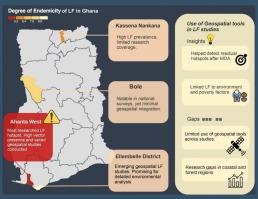Integrating geospatial tools is crucial for enhancing control strategies against human lymphatic filarial infections in Ghana: A comprehensive review
IF 2.4
Q3 INFECTIOUS DISEASES
引用次数: 0
Abstract
In Ghana, lymphatic filariasis (LF) infection transmission remains high in some endemic foci and continues to frustrate current control programs, posing serious health threats. Over the years, significant economic investments and efforts have been made to control human filarial infections in endemic regions. The need for interdisciplinary strategic action is crucial in eliminating human filarial infections. In this review, we discuss the application and integration of geospatial technology and Geographic Information Systems tools into existing control strategies to accelerate the elimination of lymphatic filarial infections in Ghana. Our analysis of six publications that have applied geospatial tools in LF in Ghana reveals the potential of geospatial tools to enhance surveillance, predict risk factors, and monitor MDA programs. It also highlights the limited integration of these tools in current LF control strategies and the need to address challenges such as data availability and funding to fully realize their benefits.

综合地理空间工具对于加强加纳人淋巴丝虫病感染控制战略至关重要:一项全面审查
在加纳,淋巴丝虫病(LF)感染传播在一些地方性疫源地仍然很高,并继续阻碍当前的控制规划,构成严重的健康威胁。多年来,为控制流行地区的人类丝虫病感染进行了大量的经济投资和努力。跨学科战略行动的必要性对于消除人类丝虫病感染至关重要。在这篇综述中,我们讨论了地理空间技术和地理信息系统工具在加纳现有控制策略中的应用和集成,以加速消除淋巴丝虫病感染。我们分析了在加纳LF应用地理空间工具的六份出版物,揭示了地理空间工具在加强监测、预测风险因素和监测MDA项目方面的潜力。它还强调了这些工具在当前LF控制策略中的有限集成,以及需要解决数据可用性和资金等挑战,以充分实现其优势。
本文章由计算机程序翻译,如有差异,请以英文原文为准。
求助全文
约1分钟内获得全文
求助全文
来源期刊

Parasite Epidemiology and Control
Medicine-Infectious Diseases
CiteScore
5.70
自引率
3.10%
发文量
44
审稿时长
17 weeks
期刊介绍:
Parasite Epidemiology and Control is an Open Access journal. There is an increasing amount of research in the parasitology area that analyses the patterns, causes, and effects of health and disease conditions in defined populations. This epidemiology of parasite infectious diseases is predominantly studied in human populations but also spans other major hosts of parasitic infections and as such this journal will have a broad remit. We will focus on the major areas of epidemiological study including disease etiology, disease surveillance, drug resistance and geographical spread and screening, biomonitoring, and comparisons of treatment effects in clinical trials for both human and other animals. We will also look at the epidemiology and control of vector insects. The journal will also cover the use of geographic information systems (Epi-GIS) for epidemiological surveillance which is a rapidly growing area of research in infectious diseases. Molecular epidemiological approaches are also particularly encouraged.
 求助内容:
求助内容: 应助结果提醒方式:
应助结果提醒方式:


